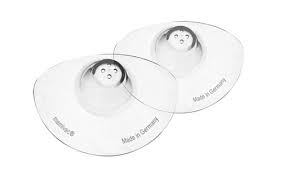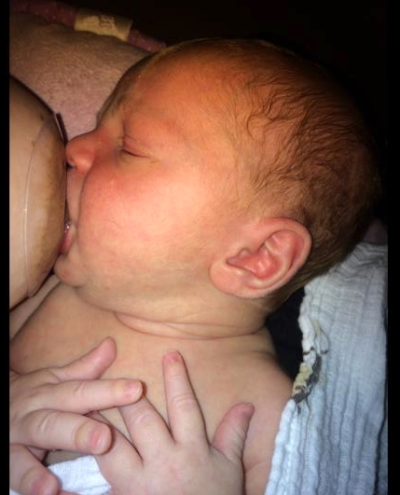Written by Robin Kaplan, M.Ed, IBCLC
Is your baby having a difficult time latching? Is breastfeeding incredibly painful? Do you have a cracked nipple that just won’t heal? Then most likely you have been recommended to try a nipple shield. While the nipple shield can often be a terrific temporary tool to help with these situations, it is important to know how to use them correctly, as well as have an exit strategy for how to discontinue usage as soon as possible.
What is a nipple shield and why is it used?
A nipple shield is a thin piece of silicone that is placed on your nipple so that your baby can feed at the breast. For the baby who cannot latch on easily (due to prematurity, difficult birth, tongue tie, etc) the nipple shield provides a definitive shape for mom’s nipple, making it easy to latch onto.....all baby has to do is open his/her mouth and start sucking. For the baby who is compressing mom’s nipples while breastfeeding (due to a tongue tie, lip tie, torticollis, receded chin, difficult birth, etc.) causing pain and cracked nipples, the nipple shield provides a temporary barrier so that the baby can still breastfeed while allowing mom’s nipples some relief and time to heal. Sometimes the nipple shield is offered to a mom just because she has flat nipples. In most cases, this isn’t really necessary, since a baby who latches on deeply doesn’t care whether mom has flat or erect nipples.
Is there a correct way to use the nipple shield?
YES! Just as with the baby who latches on to the bare breast, when a baby is latched on with the nipple shield, he/she will only be able to stimulate mom’s milk, keep up her milk supply, and effectively transfer milk if he/she has the entire nipple shield in his/her mouth. If the baby is sliding off and on the nipple shield while feeding, the baby will not be able to transfer milk well and can also cause mom a lot of nipple pain.
Depending on how long your nipple is, you might have to invert the shield before putting it on, so that your nipple goes further into the shield before latching your baby. Our DIY Breastfeeding YouTube Video, Latching: Using a Nipple Shield, demonstrates how to do this.
What are the pros and cons of using the nipple shield?
Pros:
- Mom’s nipple has an opportunity to heal without having to introduce a bottle too early to her baby.
- Premature babies who have not yet become super coordinated at latching on to mom’s bare breast and who tire quickly are able to breastfeed more easily.
- Babies who are unable to latch onto mom’s bare breast, for a variety of reasons, are able to breastfeed while the underlying challenges are addressed.
Cons:
- Babies may not be able to effectively transfer milk using the nipple shield, so baby might need supplementation even if mom’s milk supply is able to meet his/her need.
- Mom’s milk supply could potentially decrease if baby isn’t effectively stimulating her milk supply.
- Mom might get recurrent plugged ducts and/pr mastitis due to ineffective milk drainage.
- Babies can become very dependent on the nipple shield, which can make it difficult to wean from. This can make breastfeeding in public a bit of a challenge.
How can I wean my baby from the nipple shield?
Babies can become very obsessed with the nipple shield, so sometimes it can be challenging to wean them from it. This is why you always want to have an exit strategy.
- If you are using the nipple shield as a temporary band-aid while your nipples heal, try to use it for only a few days and maybe not for every feeding. If one side is less damaged than the other, only use the shield on the more damaged nipple.
- If you are using the nipple shield to help with latching difficulties, attempt each day to latch your baby without it. You never know when he/she is going to figure out how to latch without it and the daily practice should help speed up that process. Sometimes moms find it helpful to latch the baby with the nipple shield at the beginning of the feeding and then try the ‘bait and switch’ move to encourage the baby to latch back on without it once he/she has a little milk in the belly.
- If you are using the nipple shield due to baby’s inability to breastfeed well because of a tongue tie, lip tie, general chompiness, torticollis, etc., you absolutely want to schedule an appointment with a lactation consultant to help remedy these underlying issues. The use of the nipple shield might help temporarily, but it may increase your risk for breastfeeding challenges later on, which can be more difficult to fix as the baby gets older. A great IBCLC should be able to assess what is causing these breastfeeding challenges, as well as provide you with other practitioners who can help remedy the situation, such as an ENT, pediatric dentist, chiropractor, craniosacral therapist, etc.



